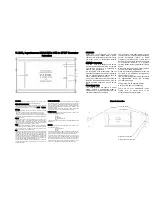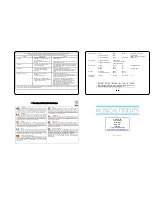
V-LINK
II
Asynchronous 24bit 96KHz USB to SPDIF Converter
Instructions
Introduction
Thank you for purchasing the V-LINK
II
asynchronous 24 bit 96kHZ USB to SPDIF
convertor. We sincerely hope that it will bring
you many years of outstanding listening
pleasure.
Installation Precautions
Your new V-LINK
II
is designed and built to
provide trouble-free performance, but as with
all electronic devices, it is necessary to
observe a few precautions:
Do not use the V-LINK
II
near water. The unit
must not be exposed to dripping or splashing
and no objects filled with liquids, such as
vases, must be placed on the unit.
Keep the V-LINK
II
away from heat such as
radiators. No naked flame sources, such as
lighted candles, should be placed on the
unit.
Power Supply Note:
The V-LINK
II
does not require a power
supply; instead it automatically draws a
small amount of operating power from the
computer USB port it connects to.
This Hi-fi product has been tested to ensure
that its operation is not adversely affected by
normal background levels of Radio
Frequency Interference (R.F.I.), and that it
does not itself generate excessive amounts
of interference. However, if a problem
persists, please contact your Musical Fidelity
agent.
Never open the case of the V-LINK
II
yourself,
as this will invalidate the guarantee.
Place all connecting cables where they are
not likely to be walked on or trapped by
items placed on them.
The V-LINK
II
will operate in accordance with
its specifications within the following
environmental range:
Temperature 5 to 45 degrees Celsius
Humidity 10 to 90% non condensing
There are no user adjustments inside.
Please refer all service work to an
authorised Musical Fidelity agent.
Front and back connections
USB input
Power LED (Blue)
Lock LED (Green)
Connections
Always switch off the equipment attached to the
V-LINK
II
before
connecting/disconnecting power, changing leads or inputs.
Digital optical or coaxial outputs
Using good quality digital RCA lead (not supplied), connect the digital
coaxial or optical output to a DAC (digital to Analogue converter) or
other digital audio input device to the V-LINK
II
SPDIF or COAXIAL
sockets.
USB input
A good quality USB A to B cable is required to connect the unit to the
computer.
Plug the B (square) end into the socket in the back of the V-LINK
II
Plug the A (rectangle) end into a free USB socket on your computer.
Once the unit is plugged in and powered, the computer should detect
the new hardware and install a generic driver automatically (No setup or
driver disk required).
Outputs
Connect the V-LINK
II
outputs to the digital inputs of a DAC or other
digital media system. It is advisable to have the amplifier turned off at
this point. Coaxial or optical may be used. A top quality optical
transmitter is used to obtain reliable performance at 96kHz, and has the
added advantage of inherent galvanic isolation, if used.
Power
The unit draws it’s miniscule power requirement from the USB host ie
the computer to which it is attached. The blue LED will light to confirm
the unit is ready for use, and the green LED will be lit once music is
playing, indicating presence of digital signal.
Use
The V-LINK
II
is designed to obtain maximum benefit from high quality
digital audio files stored on a computer, in conjunction with a high
quality DAC, such as our V-DAC
II
. It will allow up to 96kHz 24 bit
sampled files (e.g. FLAC files) to be converted to an SPDIF stream, for
full high resolution processing by the following DAC. This will give the
best listening experience using the full capability of the original 24 bit
and high sample rate. Lower sample rate files, e.g. CD-originated music
are simply passed through at their original sample rate.
Turn the volume on amplifier to normal listening levels, sit back and
enjoy the music. These products have been designed so that they may
be left on indefinitely.
Additional USB information
On the host computer, a new mixer will be available, which is the default
mixer whenever the DAC is plugged in. Use this mixer to select the
source or adjust levels if required. CD, MP3, WAV files played on any
software should now play through the DAC. This device has been
designed to work with Windows XP, Windows VISTA, Windows 7 and
Apple OS X onwards.
The computer drivers for the USB input of the V-LINK
II
should install
automatically. To check correct installation follow these steps:
PC /Windows users
Check the computer has picked up the device and is currently using it
by clicking: (most Windows versions)
-
Start
-
Settings
-
Control panel
-
Sounds and Multimedia
-
Audio
Check “Musical Fidelity VLINK” appears under PREFERRED AUDIO
DEVICE tab
Mac users
Check the computer has picked up the device and is currently using it
by clicking: (MAC OS X)
-
System preferences
-
Hardware
-
Sound
Check that “Musical Fidelity VLINK” is selected under the OUTPUT tab.
If the computer’s warning sounds/chimes are to played through the
DAC, make sure it is selected under the SOUND EFFECTS tab too.
This device is a high speed serial data processor, and by its nature,
requires a very high volume of USB bandwidth. It will benefit greatly
from being the only device connected on its USB ‘port’. Sharing the
same port with other devices may cause unwanted artefacts such as
dropouts or temporary loss of signal. This especially includes the use of
the DAC on a USB hub/splitter alongside other USB components.
Digital Coaxial output RCA
Digital Optical Output TOSLINK



















